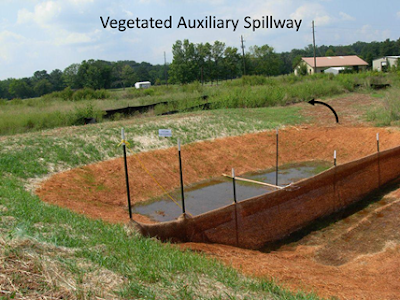Today’s Erosion and Sediment Control Tip: #8
The best auxiliary spillway is a vegetated spillway (pictured) located around the end or abutment of the dam on undisturbed soil. The Blue Book contains design guidance for this type auxiliary spillway.
However, a vegetated auxiliary spillway is not always possible, and a spillway “over the embankment” is often used. In this case, the exit slope on the back of the embankment (dam) is usually where the system becomes unstable due to the high velocities associated with what is called super-critical flow. Riprap is often the lining of choice and it often moves or dislodges at this location. The rock must be properly sized to be “stable”. And here lies the problem. When the outlet portion of the auxiliary spillway is placed on the same slope as the embankment (probably a 2.5:1 or 3:1), the riprap would probably have to be ALDOT Class III rock to be stable. This is huge rock. The outlet slope of the auxiliary spillway would need to be flattened to a 4:1 or 5:1 to use a smaller sized riprap (Class II). It may be possible to use other manufactured armoring products for the auxiliary spillway too. These would need to be properly designed for the flow and stress conditions.
A riprap auxiliary spillway is basically a chute spillway
and should be designed as such. So, put on your thinking cap and sharpen
your pencil when designing an auxiliary spillway. It is not just a bunch
of rocks placed over a dam. When installing a riprap auxiliary spillway
ensure it has the cross-sectional capacity required in the plans. Riprap
is often placed too high (picture). If excess water cannot go out the
auxiliary spillway it could cause a breach in the dam and failure.





Comments